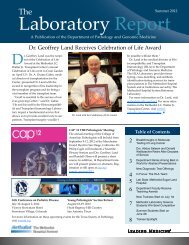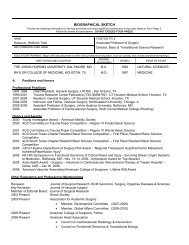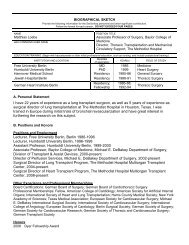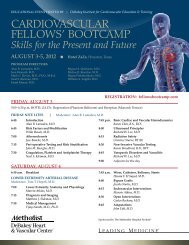The Facts Karla M. Ku - The Methodist Hospital
The Facts Karla M. Ku - The Methodist Hospital
The Facts Karla M. Ku - The Methodist Hospital
You also want an ePaper? Increase the reach of your titles
YUMPU automatically turns print PDFs into web optimized ePapers that Google loves.
O B E S I T Y A N d C A R d I OVA S C U L A R d I S E A S E :<br />
A B A d R E L AT I O N S H I P T H AT N E E d S TO C H A N G E<br />
P e t e r H . J o n e s<br />
F r o m M e t h o d i s t D e B a k e y H e a r t C e n t e r, H o u s t o n , Te x a s<br />
IntRoduCtIon<br />
obesity is strongly associated with an increased risk of cardiovascular disease, and conventional wisdom reasons<br />
that reducing weight would favorably reduce that risk. 1 an abundance of evidence associates excess adipose tissue,<br />
particularly in the visceral compartment, with insulin resistance, a risk for developing diabetes, increased blood<br />
pressure and lipoprotein disorders (low high-density lipoprotein, cholesterol and high triglycerides). there also is<br />
evidence that short-term weight loss can improve insulin sensitivity, reduce blood pressure and improve lipoprotein<br />
levels. 2 unfortunately, there are no long-term randomized clinical trials that demonstrate a reduction in cardiovascular<br />
endpoints with sustained weight loss. an obvious explanation is the lack of effective methods to induce and sustain<br />
weight loss over many years in most people.<br />
the complex biologic and genetic relationship of hunger and energy balance is finally receiving much-needed<br />
scientific attention, and new research is focusing on lifestyle habits, such as the composition of food intake and<br />
exercise, and drugs that modulate hunger/satiety and energy expenditure. even so, the dramatic global rise in obesity<br />
threatens the progress thus far in reducing cardiovascular disease (CVd) risk factors. this article examines the<br />
epidemic of obesity, its effect on traditional CVd risk factors and the effect of weight loss on controlling CVd risk.<br />
o B e s I t Y a n d<br />
C a R d I o Va s C u l a R d I s e a s e<br />
Observational studies have established<br />
that the risk of total and cardiovascular<br />
mortality increases progressively as<br />
the body mass index (BMI) rises over<br />
25 kg/m 2 . Over the past decade, the<br />
prevalence of obesity has increased<br />
to where more than 30% of U.S.<br />
adults have a BMI >30 kg/m 2 . 3 <strong>The</strong><br />
prevalence is influenced by age, gender<br />
and ethnicity, with a graded increase<br />
as one ages and a higher prevalence in<br />
women and Hispanics.<br />
Obesity influences numerous disease<br />
states that impact longevity and quality<br />
of life, such as type 2 diabetes, hypertension,<br />
coronary heart disease (CHD),<br />
stroke, obstructive sleep apnea, nonalcoholic<br />
fatty liver disease, osteoarthritis<br />
and cancer. Recent analysis from the<br />
National Health and Nutrition<br />
Examination Survey (NHANES) I, II<br />
and III that followed patients from<br />
1971 to 1994 show that Caucasian men<br />
and women at age 20 with a BMI >45<br />
have 8-13 years of lost life compared to<br />
similar-aged subjects with a BMI of 24. 4<br />
Likewise, African-American men and<br />
women with a BMI >45 at age 20 have<br />
5-20 years of lost life.<br />
This increase in obesity prevalence<br />
has not escaped our children, and this<br />
alarming trend is threatening their<br />
life expectancy. 5 <strong>The</strong> cause is probably<br />
not the result of genetic alterations.<br />
Although genetics play a major role in<br />
one’s propensity for obesity, the change<br />
in lifestyle habits — larger portion sizes,<br />
readily available high-calorie foods,<br />
sedentary lifestyle — over the past few<br />
decades has been a major contributor. 6<br />
<strong>The</strong> health benefits of weight loss have<br />
been confined to various low-caloric<br />
diets that produced at least a 5-10%<br />
reduction in body weight, which in turn<br />
showed significant reductions in systolic<br />
and diastolic blood pressure, glucose,<br />
LDL cholesterol and triglycerides and<br />
increases in HDL cholesterol. A recent<br />
meta-analysis of clinical outcomes<br />
from bariatric surgery has confirmed<br />
the impressive improvement in obesityrelated<br />
comorbidities with substantial<br />
weight loss. 7 With an average loss of<br />
60% of excess weight following surgery,<br />
77% of type 2 diabetics had normal<br />
glucoses, 70% of dyslipidemic patients<br />
improved, 62% of hypertensives had<br />
resolution, and 86% of obstructive<br />
sleep apnea subjects resolved their<br />
symptoms. Although there have been<br />
no hypocaloric diet or anorectic drug<br />
randomized clinical trials performed to<br />
evaluate hard cardiovascular endpoints,<br />
it is presumed that the improvement<br />
in surrogate cardiovascular risk factors<br />
(blood pressure, glucose control,<br />
lipoproteins) with short-term weight loss<br />
would translate to long-term benefits.<br />
With this in mind, the National Heart<br />
Lung and Blood Institute (NHLBI)<br />
recommends that weight-loss treatment<br />
be offered to patients with a BMI >30 or<br />
between 27-29.9 with two or more risk<br />
factors for vascular disease, one of which<br />
can be high waist circumference. 8 <strong>The</strong><br />
goal of a weight-loss treatment should<br />
be 10% of baseline weight within six<br />
months followed by a maintenance<br />
program and further weight loss if<br />
feasible. <strong>The</strong> NIH classification of<br />
overweight and obese — with the risk<br />
for type 2 diabetes, hypertension and<br />
1 II (1) 2006 | JMDHC
















